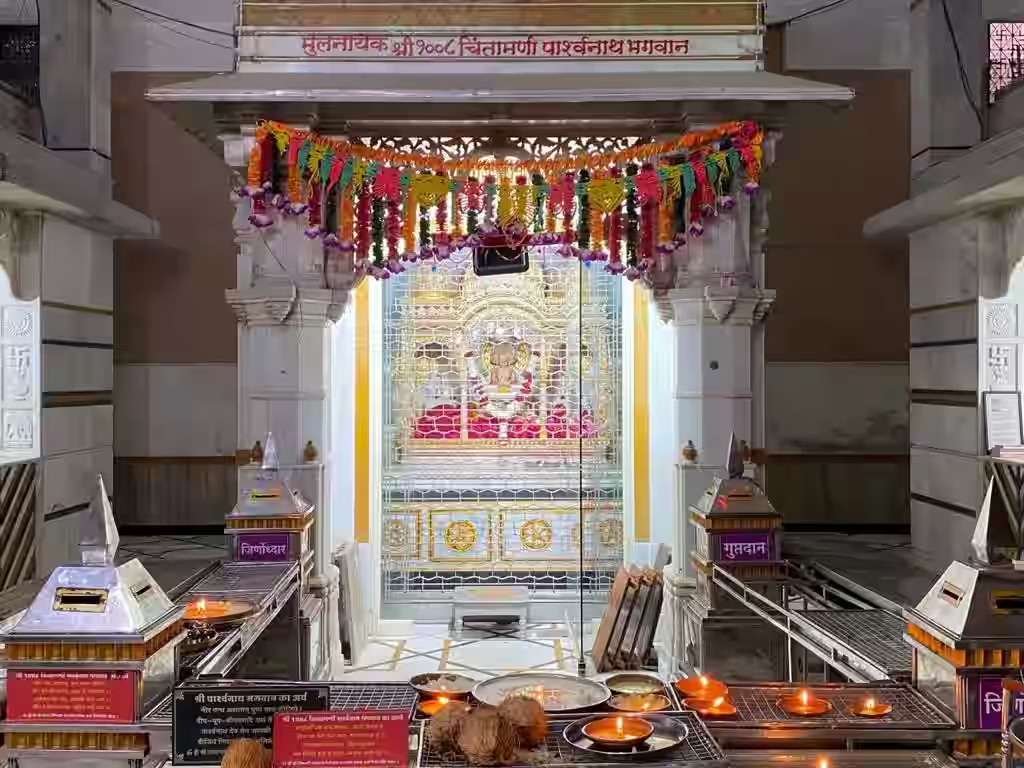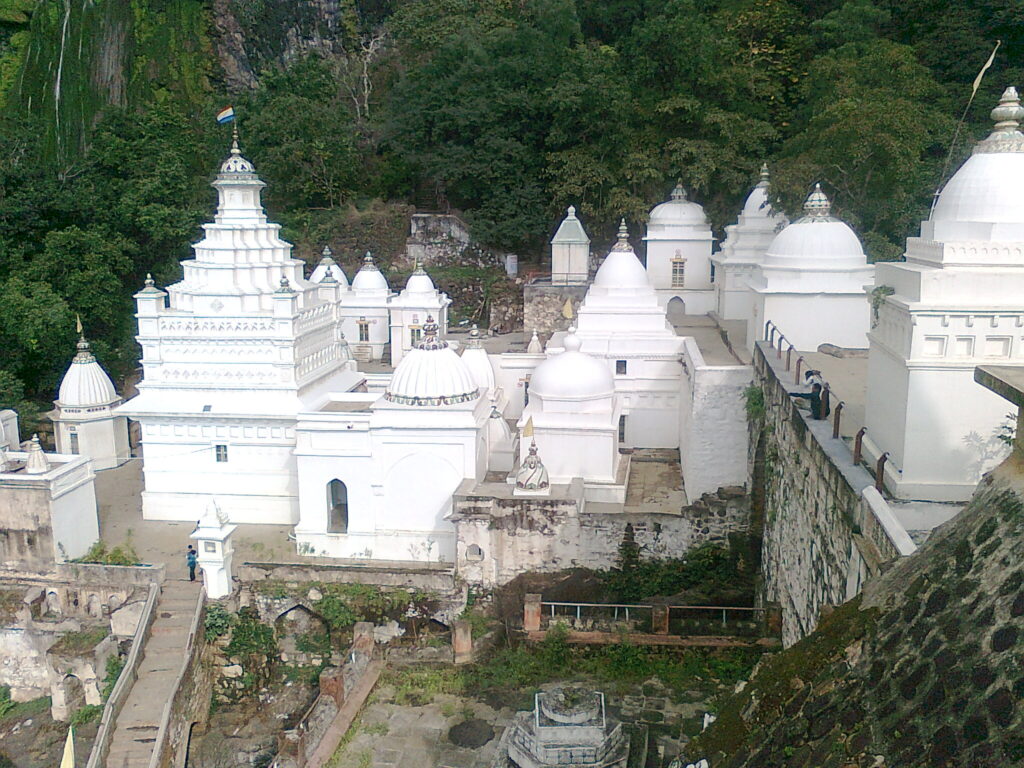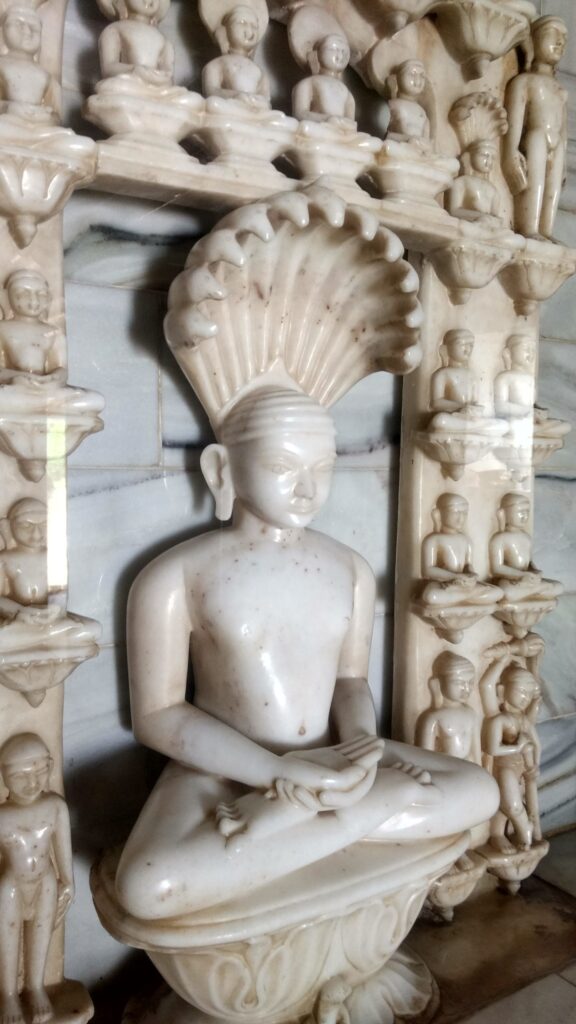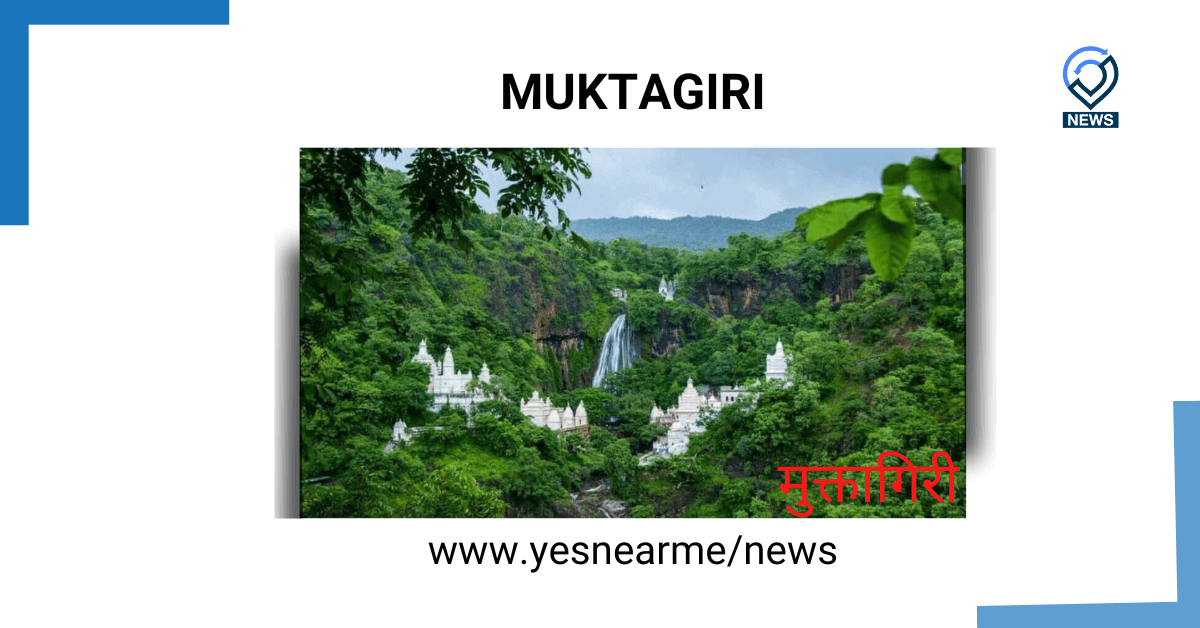Shri Digambar Jain Siddha Kshetra Muktagiri: A Sacred Pilgrimage Site

Muktagiri, also known as Mendhagiri, is a revered Jain pilgrimage site situated on the border of Maharashtra and Madhya Pradesh. It is located in the Betul district of Madhya Pradesh, near the Amravati district of Maharashtra. This sacred site is considered one of the most significant Siddha Kshetras in Jainism, where numerous monks are believed to have attained moksha (liberation). Muktagiri is not only a place of spiritual importance but also a destination known for its breathtaking natural beauty, with lush green surroundings and mesmerizing waterfalls.
The significance of Muktagiri dates back centuries, with references found in Jain scriptures and ancient texts. It is a site of deep reverence where devotees come to seek blessings, practice asceticism, and experience a sense of peace and tranquility. The 52 temples spread across the hilly landscape are architectural marvels that symbolize devotion, history, and the artistic heritage of Jainism. The serene ambiance, coupled with the divine energy that is believed to pervade the region, makes Muktagiri a must-visit for spiritual seekers and tourists alike.
Apart from being a pilgrimage center, Muktagiri also attracts nature lovers due to its picturesque surroundings. The Muktagiri Waterfall, which cascades down the hills, enhances the beauty and sanctity of this place, making it an ideal destination for meditation and introspection. The site is not just a religious landmark but also a sanctuary of peace and nature’s splendor, offering a perfect blend of spirituality and scenic charm.
Historical and Religious Significance of Muktagiri
Muktagiri holds a profound place in Jain history and spirituality, serving as a revered pilgrimage site for devotees, particularly those from the Digambara Jain tradition. It is believed that 3,000 Jain monks attained nirvana (liberation) at this sacred site, making it a place of immense religious significance. The name “Muktagiri” itself resonates with the concept of “Mukti” (salvation), symbolizing the spiritual emancipation attained by countless ascetics over centuries.
A Hub of Ascetic Practices
Ancient Jain scriptures and historical texts mention that Muktagiri has been a center of intense ascetic practices, meditation, and penance. Numerous saints and monks have chosen this site to renounce worldly attachments, dedicating themselves to the pursuit of enlightenment. The serene and secluded environment of the region, surrounded by lush greenery and cascading waterfalls, has made it an ideal location for deep spiritual introspection.
Association with Jain Tirthankaras
Muktagiri is closely linked with Jain Tirthankaras, the revered spiritual teachers in Jainism. The temples in this region are believed to be blessed with divine energies, making them a place of great punya (spiritual merit) for those who visit and offer prayers. Many devotees believe that worshipping at Muktagiri brings prosperity, peace, and spiritual growth.
Historical and Architectural Heritage
The historical roots of Muktagiri trace back several centuries, reflecting the rich legacy of Jain culture and architecture. The cluster of 52 temples, intricately built along a hill range, showcases the excellence of medieval Jain temple architecture, with detailed carvings, sculptures, and inscriptions that narrate the stories of Jain saints and their teachings. Some inscriptions found in these temples suggest that they were patronized by various dynasties, who contributed to the growth and preservation of Jain heritage in the region.
A Pilgrimage of Great Virtue
For Jain followers, visiting Muktagiri is considered an act of immense religious merit, equivalent to performing major religious rituals. Pilgrims undertake this journey with great devotion, often observing strict religious vows and practices. It is believed that the spiritual energy of Muktagiri enhances one’s karma, bringing them closer to the path of liberation (moksha).
Today, Muktagiri continues to attract thousands of devotees and tourists who seek spiritual fulfillment and wish to experience the tranquil, sacred atmosphere of this historically rich pilgrimage site.

Architectural Marvel: The 52 Jain Temples
One of the most captivating aspects of Muktagiri is its 52 beautifully carved Jain temples, which are spread across the Satpura mountain ranges. These temples are built in different periods and showcase exquisite Jain architectural styles. The temples are arranged systematically, each carrying historical and spiritual significance.
Architectural Marvel: The 52 Jain Temples of Muktagiri
Nestled in the heart of the Satpura mountain ranges, Muktagiri stands as a breathtaking spiritual and architectural wonder. This sacred Jain pilgrimage site is home to 52 intricately carved Jain temples, each of which narrates a tale of devotion, artistic grandeur, and historical importance. These temples, spread across lush greenery and cascading waterfalls, create a mesmerizing landscape that attracts devotees and architecture enthusiasts alike.
The temples, constructed over different periods, exhibit the finest examples of Jain architectural styles, featuring detailed carvings, ornate domes, and serene idols of Tirthankaras. The arrangement of the temples follows a well-planned structure, leading pilgrims on a journey of spiritual ascension as they progress through the temples, each possessing unique historical and religious significance.
Key Highlights of the Temples:
- Temple No. 10 – Considered the main temple of Muktagiri, it is dedicated to Bhagwan Parshvanath, the 23rd Tirthankara of Jainism. The temple enshrines a majestic idol of Parshvanath, which is deeply revered by pilgrims who seek blessings and spiritual peace.
- Temple No. 26 – This temple holds a unique distinction as it contains the sacred footprints of revered Jain ascetics and saints. These footprints symbolize the presence and spiritual attainment of enlightened souls who once walked this sacred land, making it a site of deep reverence for followers of Jainism.
- Temple No. 4 – Dedicated to Bhagwan Mahavir, the 24th and last Tirthankara, this temple is a significant place of worship where devotees pay homage to his teachings of non-violence, truth, and righteousness. The temple’s architectural elegance and peaceful ambiance provide an ideal environment for meditation and spiritual reflection.
- Temple No. 51 – A historically significant temple, this sacred site is believed to be the place where numerous Jain monks attained salvation (moksha). This makes it an important pilgrimage destination for those seeking enlightenment and liberation from worldly sufferings.
Architectural Brilliance and Spiritual Significance
The Muktagiri temples display stunning craftsmanship with their ornate pillars, intricately sculpted facades, and finely detailed domes. The entire complex is designed to harmonize with nature, with waterfalls and dense forests adding to its divine aura. Each temple carries a distinct identity, yet collectively, they form a unified spiritual retreat that has been a center of devotion for centuries.
Beyond their architectural beauty, these temples hold immense spiritual value, as they continue to inspire countless Jain devotees to embark on a journey of self-purification and enlightenment. The peaceful surroundings and the aura of devotion make Muktagiri a must-visit destination for both pilgrims and lovers of ancient architecture.
Whether one seeks divine blessings, historical insights, or architectural splendor, the 52 Jain temples of Muktagiri offer an unforgettable experience that captures the essence of Jain heritage and spirituality.
Natural Beauty and Serenity
Muktagiri is not only a sacred pilgrimage site but also a haven for nature lovers. Nestled in the heart of the Satpura hills, it offers an enchanting retreat surrounded by unspoiled natural beauty. The entire landscape is a harmonious blend of lush green forests, cascading waterfalls, and intriguing natural caves, making it a perfect destination for those seeking tranquility and spiritual rejuvenation.
One of the most captivating sights at Muktagiri is the Muktagiri Waterfall, which gracefully descends from the hilltop, enhancing the divine and mystical charm of the place. The rhythmic sound of the flowing water, combined with the melodious calls of birds and the gentle mountain breeze, creates a serene ambiance ideal for meditation, introspection, and relaxation. The waterfall not only adds to the spiritual significance of the site but also serves as a picturesque spot for visitors to unwind and connect with nature.
As you explore further, you’ll find dense forests teeming with diverse flora and fauna, providing a refreshing escape from the chaos of urban life. The region’s natural caves add an element of mystery, enticing adventurers and history enthusiasts alike. Whether you’re a pilgrim seeking solace, a traveler looking for breathtaking landscapes, or a nature enthusiast eager to explore the wilderness, Muktagiri offers an experience that soothes the mind, body, and soul.

Religious Practices and Festivals
Muktagiri is an active pilgrimage site where daily rituals, prayers, and religious discourses take place, fostering a deep spiritual ambiance. The temple complex resonates with devotional activities such as morning and evening aartis, chanting of Jain scriptures, and meditation sessions. Devotees and monks often engage in religious discussions, spreading the teachings of Bhagwan Mahavir and Jain philosophy.
The site also serves as a center for various Jain festivals, celebrated with great enthusiasm and reverence. These festivals attract thousands of devotees from across the country, creating an atmosphere of devotion and unity. Some of the major events observed at Muktagiri include:
-
Mahavir Jayanti – The birth anniversary of Bhagwan Mahavir is celebrated with grand processions, special rituals, and discourses on his teachings. Devotees offer prayers, participate in charitable activities, and engage in acts of kindness and compassion.
-
Paryushan Parva – Considered the most significant festival in Jainism, Paryushan is a time of deep reflection, penance, and self-discipline. Jains observe fasting, attend spiritual discourses, and seek forgiveness from all beings. The festival concludes with Samvatsari, a day dedicated to seeking and granting forgiveness.
-
Kartika Purnima – This auspicious day holds special significance for Jain devotees, who gather at Muktagiri to offer prayers, perform religious rituals, and seek blessings. The festival marks an important spiritual occasion for purification and renewal of faith.
-
Annual Mela (Fair) – A grand fair is organized every year, drawing pilgrims in large numbers. The fair features religious ceremonies, cultural performances, and stalls selling traditional Jain literature and sacred items. It serves as a time for communal gathering and devotion.
In addition to these major festivals, various other Jain observances such as Daslakshan Parva, Diwali (marking Lord Mahavir’s Nirvana), and Ayambil Oli (a period of disciplined fasting and meditation) are also practiced with deep reverence at Muktagiri.
Muktagiri in Jain Literature
Muktagiri holds a revered place in Jain literature, where it is frequently mentioned as a Siddha Kshetra—a holy site where numerous Jain monks attained moksha (liberation) through intense penance and meditation. Over centuries, Jain scriptures, hymns, and historical texts have celebrated Muktagiri as a land of spiritual enlightenment, attracting sages, ascetics, and devotees seeking salvation.
References in Jain Scriptures
Several ancient and medieval Jain texts document the importance of Muktagiri as a center of ascetic practices:
- Muni Prabhachandra’s writings refer to Muktagiri as a sacred land where thousands of Jain saints renounced worldly attachments and attained liberation.
- Jain scholars have described Muktagiri as a place of divine energy, where practicing austerity is believed to yield immense punya (spiritual merit).
- Many Digambara Jain granths (scriptures) mention the region as a tirtha (pilgrimage site) that has been visited by monks and scholars for generations.
Hymns and Devotional Texts
Over the centuries, Jain monks and poets have composed hymns (stotras) and prayers dedicated to Muktagiri, glorifying its spiritual significance:
- These verses describe the tranquil ambiance, sacred vibrations, and purifying presence of the site.
- Several Acharyas (Jain spiritual leaders) have written about Muktagiri’s role in Jain philosophy, emphasizing its contribution to spiritual awakening and self-discipline.
- Some texts highlight the architectural and historical beauty of Muktagiri’s 52 temples, describing them as places where devotees can experience divine bliss.
Muktagiri’s Role in Religious History
Historians and Jain scholars have recognized Muktagiri as an essential site in the evolution of Jainism in central India:
- It has been a center for religious discourses, debates, and scriptural studies, where monks gathered to discuss Jain doctrines and philosophy.
- Many Jain Acharyas and saints have resided in Muktagiri for their chaturmas (monastic retreats during the rainy season), contributing to the spread of Jain teachings.
- Some ancient palm-leaf manuscripts and inscriptions found in Muktagiri’s temples provide valuable insights into the religious history of the region.
Scientific and Archaeological Relevance
The ancient Jain temples of Muktagiri have also been a subject of archaeological studies, revealing insights into the construction techniques, iconography, and artistic styles prevalent during different periods of Indian history. The rock-cut architecture, intricate carvings, and inscriptions found in the temples provide valuable information about the Jain community’s contributions to Indian heritage.
Spiritual and Meditative Importance
Muktagiri is considered an ideal location for meditation and spiritual retreats. The tranquil surroundings, away from the hustle and bustle of urban life, make it a perfect place for seekers of inner peace and enlightenment. Jain monks and devotees often visit the site to engage in deep meditation, study scriptures, and follow the principles of Jainism in an undisturbed environment.
How to Reach Muktagiri
Muktagiri is a well-connected pilgrimage site, accessible through road, rail, and air, ensuring a smooth journey for devotees and travelers. Nestled in the serene Satpura hills on the border of Maharashtra and Madhya Pradesh, this sacred Jain tirtha attracts visitors from across the country.
By Road
Muktagiri is easily reachable by road from several major cities in Maharashtra and Madhya Pradesh. Well-maintained highways and state roads connect the pilgrimage site to nearby urban centers:
- Betul (65 km) – The closest town with good road connectivity. Regular taxis and private vehicles are available.
- Amravati (95 km) – A key city in Maharashtra, offering frequent bus services and private cabs.
- Nagpur (185 km) – A major city with excellent road connectivity; travelers can hire taxis or board state transport buses.
- Paratwada (78 km) – Another nearby town from where buses and taxis frequently operate.
Private vehicles, cabs, and state-run buses operate regularly, making Muktagiri a convenient road trip destination for pilgrims and tourists alike.
By Rail
The nearest railway station to Muktagiri is:
- Betul Railway Station (65 km) – A well-connected station on the Delhi-Chennai main railway line, providing connectivity to various cities like Bhopal, Nagpur, Jabalpur, and Itarsi.
- Upon reaching Betul, travelers can hire taxis or private vehicles to complete the journey to Muktagiri. Shared cabs and local transport are also available.
By Air
For those traveling from distant cities, the nearest airport is:
- Dr. Babasaheb Ambedkar International Airport, Nagpur (185 km) – A major airport with domestic and international flights, connecting to cities like Mumbai, Delhi, Bengaluru, Hyderabad, and Pune.
- From the airport, travelers can take a prepaid taxi, private cab, or bus to reach Muktagiri.
Additional Travel Tips
- The last stretch leading to the temples involves a short trek with steps, so visitors should wear comfortable footwear.
- It is advisable to check weather conditions before planning a visit, as monsoon season makes the roads slippery.
- Local guides and transportation services are available near Betul and Paratwada for a hassle-free journey.
Muktagiri’s accessibility through various transport modes makes it a popular and convenient pilgrimage destination, attracting devotees and tourists year-round.
Accommodation and Facilities
Muktagiri provides comfortable Dharamshalas (rest houses) specifically designed for Jain pilgrims. These Dharamshalas offer clean, well-maintained rooms and serve Jain food prepared according to strict vegetarian and satvik principles, ensuring a peaceful and pure stay for devotees. Some Dharamshalas also offer facilities like hot water, meditation halls, and prayer rooms to enhance the pilgrimage experience.
For those seeking alternative accommodations, nearby towns such as Betul and Amravati have a range of hotels, lodges, and guest houses, catering to different budget preferences. These accommodations provide modern amenities while maintaining proximity to Muktagiri, allowing visitors to explore the temples conveniently.
Additionally, Muktagiri has basic facilities such as drinking water, rest areas, and transportation access, ensuring a smooth and comfortable visit for devotees and tourists alike.
Conclusion
Shri Digambar Jain Siddha Kshetra Muktagiri is a sacred destination where spirituality seamlessly merges with nature’s splendor. It stands as a testament to devotion, history, and architectural brilliance, making it a must-visit pilgrimage site not only for Jains but also for anyone seeking peace, enlightenment, and an escape from the fast-paced modern world.
The tranquil environment, enriched by the soothing sounds of cascading waterfalls and the whispers of the wind through dense forests, creates a perfect setting for introspection and spiritual awakening. The beautifully crafted temples, adorned with intricate carvings and imbued with centuries of religious significance, offer a deep sense of reverence and awe to visitors.
Beyond its religious importance, Muktagiri serves as a retreat for nature lovers and travelers looking for solace in the lap of the Satpura hills. The combination of its historical legacy, natural charm, and serene ambiance makes it an unparalleled destination for those in search of inner peace and divine connection.
A visit to Muktagiri is not just a religious journey—it is an experience that touches the soul, awakens the spirit, and leaves an everlasting impression on the heart. Whether you seek devotion, tranquility, or the sheer beauty of nature, Muktagiri welcomes you with open arms, offering an unforgettable blend of spirituality and serenity.
For More Info You Can Visit Here .
Want to read more articles like this? Explore now!







Recent Comments